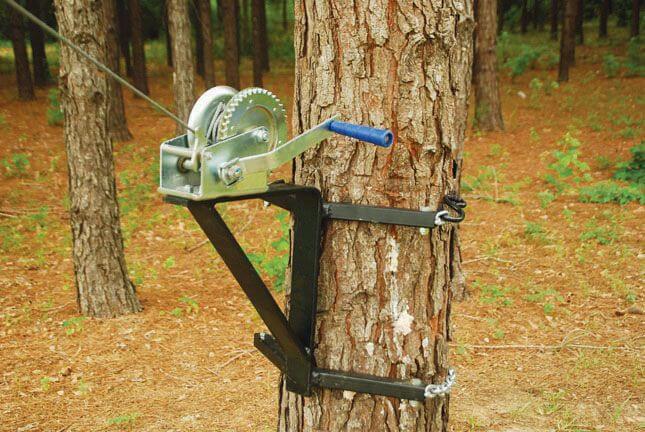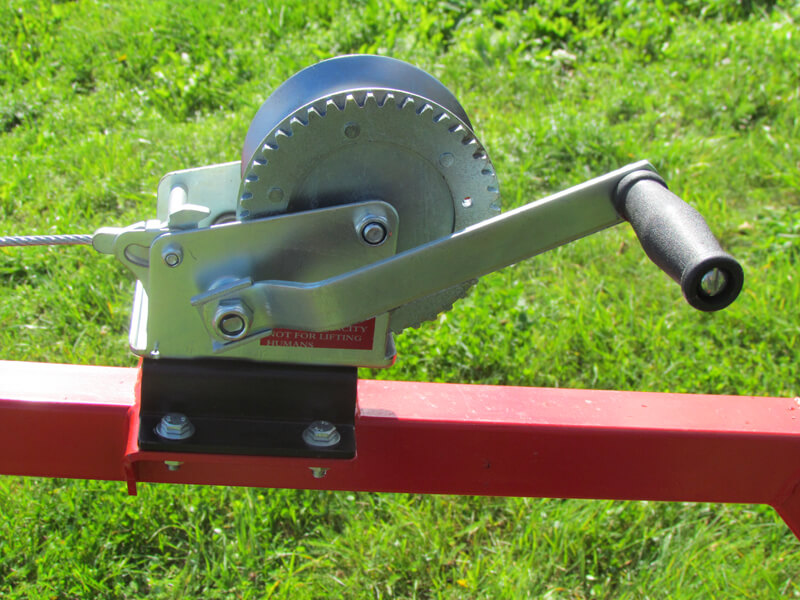Attaching a hand winch to a tree or post safely is essential for off-road recovery, towing, and lifting operations. This guide explains how to choose a secure anchor point, use the correct gear like tree saver straps and shackles, and follow proven safety steps. Whether you’re on a trail or in your backyard, these instructions ensure a stable setup and prevent common winching mistakes.
Quick Summary
- Use a tree saver strap around the base of a healthy tree.
- Choose anchor points like trees or reinforced posts.
- Avoid sharp edges or high angles to reduce tension.
- Always use rated shackles and inspect equipment for wear.
- Keep the winch line straight and tensioned during use.
How to Choose the Right Tree or Post as an Anchor Point

Choosing the right anchor for your best hand winch involves more than just picking any tree or post. The anchor must be capable of handling the force applied by the winch without moving, breaking, or causing harm to the environment.
- Size and Strength Requirements: The diameter and structural integrity of the tree or post are paramount. It should be large and robust enough to withstand the tension without bending or snapping.
- Condition: Opt for a tree or post that’s healthy and free from rot or disease. A compromised anchor can be a safety hazard, risking failure under load.
- Safety Considerations: Ensure that using the tree or post won’t cause ecological damage or present dangers to people or property nearby.
Before even selecting the tree or post, it’s crucial to ensure you’re using a reliable and durable hand winch to match your needs. If you’re still in the process of choosing, explore our curated list of the best hand winches for off-road and heavy-duty use to find models designed for strength, portability, and ease of setup.
How to Prepare a Tree or Post for Winching
Before attaching the winch, a thorough inspection of the tree or post is necessary. This step is about identifying and mitigating potential risks.
- Inspecting for Hazards: Look for signs of weakness or instability in your chosen anchor.
- Clearing the Area: Remove anything that could interfere with the attachment or operation, such as loose bark or debris.
- Protecting the Anchor: Use padding or protective wrapping to prevent damage to the tree or post, preserving its integrity and health.
Attaching the Hand Winch to a Tree

Attaching a hand winch to a tree involves several careful steps to ensure that the setup is both secure and minimally invasive to the tree’s health. Let’s break down each step for a clearer understanding.
1. Positioning
Choosing the correct height and angle for the winch is critical for a few reasons:
- Direction of Pull: The winch should be positioned in such a way that the direction of the pull is aligned with the load. This alignment ensures that the force exerted is efficient, minimizing strain on the winch and the tree.
- Nature of the Load: Consider what you’re moving or lifting. The height at which the winch is attached can affect the leverage and the ease with which the load can be manipulated.
- Accessibility: Ensure that the winch is at a height that is both safe and accessible for the operator. This means not too high to require unnecessary lifting or reaching and not too low to be awkward or potentially hazardous.
2. Method of Attachment
Using the right materials to attach the winch to the tree is essential for both the tree’s health and the operation’s safety:
- Tree-Friendly Straps or Chains: Special straps designed for this purpose are wide and made of a soft material that distributes the load over a larger area of the tree’s bark. This reduces the risk of cutting into or damaging the bark, which is vital for the tree’s health. Chains, while more durable, should be used with caution and padding to prevent damage.
- Even Distribution of Force: By distributing the force around a larger area, these materials help prevent the tree from being damaged under the tension of the load. This is crucial for maintaining the integrity of your anchor point throughout the operation.
3. Securing the Winch
Attaching the winch securely involves a step-by-step approach:
- Wrap the Strap or Chain: Start by wrapping your chosen material around the tree at the chosen height. Ensure it is positioned straight and evenly around the trunk.
- Connect to the Winch: Once the strap or chain is in place, connect it to the winch. This might involve threading the end through a slot or attaching it to a hook on the winch.
- Tightening: Carefully tighten the strap or chain so that it is snug against the tree but not so tight as to cause damage. Ensure there is no slippage and that the winch is firmly anchored.
4. Safety Tips
- Double-Check Your Setup: Before starting to use the winch, double-check every component of the setup. Make sure the straps or chains are properly secured and that the winch is stable.
- Avoid Damage to the Tree: Never use materials that could cut into the tree’s bark, such as wire or thin rope. The health of the tree is paramount, and such damage can lead to disease or the tree’s eventual death.
- Operational Safety: Always stand clear of the load and the line of pull. Ensure that all bystanders are also at a safe distance. The area around the winch and the load should be kept clear to avoid accidents.
Attaching the Hand Winch to a Post

Attaching a hand winch to a post requires precision and consideration of the materials and methods used to ensure a secure and effective setup. Here’s a detailed explanation of each step involved:
1. Choose the Right Hardware for a Post
The selection of hardware is critical and should be based on both the post’s material (wood, metal, etc.) and its physical dimensions.
- Eye Bolts and U-Bolts: These are common choices for attaching winches. Eye bolts provide a looped end to secure connections, while U-bolts wrap around the post and secure on the other side, offering a sturdy anchor point for the winch.
- Material Compatibility: Ensure that the hardware material is suitable for the type of post you’re using. For instance, use galvanized or stainless steel hardware for outdoor or treated posts to prevent corrosion.
- Size Appropriateness: The hardware must be appropriately sized for the post. It should be large enough to handle the load without causing damage to the post or failing under stress.
2. Install the Winch Mount Securely
Installing the hardware properly is paramount to maintain the stability and integrity of the winch setup.
- Drilling Pilot Holes: For wooden posts, drill pilot holes to prevent the wood from splitting when inserting eye bolts or screws. The hole should be slightly smaller than the bolt’s diameter to ensure a tight fit.
- Securing the Hardware: Insert the eye bolts or U-bolts through the drilled holes or around the post. If using U-bolts, ensure they encircle the post snugly and attach the securing plates and nuts on the opposite side.
- Tightening: Use appropriate tools to tighten the hardware, ensuring it is firmly attached to the post. Avoid overtightening, which can cause damage to the post or deform the hardware, compromising its load-bearing capacity.
3. Align the Winch for Direct Pulling
Proper alignment of the winch is essential for efficient operation and to minimize wear on the winch and the attachment point.
- Optimal Height: Position the winch at a height that aligns with the load’s center of gravity to ensure efficient pulling or lifting. This reduces strain on the winch and the attachment point.
- Direction of Pull: Align the winch so that it faces the direction of the pull directly. This ensures the force is applied evenly and optimally, enhancing safety and effectiveness.
4. Post Attachment Safety Considerations
Safety is paramount when working with winches and posts, not only for the operator but also for the stability of the structure.
- Check for Stability: Before attaching the winch, ensure the post is stable and securely anchored in the ground. A wobbly or loosely installed post could fail under load.
- Inspect for Damage: Regularly inspect both the winch and the hardware for signs of wear or damage. Replace any components that show signs of deterioration.
- Operational Safety: Always maintain a clear area around the winch during operation. Keep hands and clothing away from moving parts, and ensure all bystanders are at a safe distance.
Checking and Adjusting the Attachment
The process of checking and adjusting the attachment of a hand winch to a tree or post is a critical part of ensuring the safety and effectiveness of its use. This process can be broken down into detailed steps to ensure thoroughness and precision.
Inspection for Security
Regular inspection is vital to identify any potential issues that could compromise the safety or functionality of the winch setup. This includes checking for loosening, wear and tear, or damage to any part of the attachment system.
- Visual Inspection: Periodically, visually examine the attachment point, looking for signs of stress, such as bending, stretching, or wear on the straps, chains, or hardware used for attachment. Also, inspect the tree or post for signs of damage or movement.
- Physical Inspection: Test the tightness of bolts, straps, and other fastening devices by hand. Gently tug on the winch and the attachment point to feel for any movement that could indicate loosening.
- Check for Wear and Tear: Look closely at the straps, chains, and hardware for any signs of fraying, rust, or metal fatigue. These conditions can weaken the attachment over time, leading to potential failure under load.
Adjustments
Following the inspection, any identified issues should be addressed promptly to maintain a secure attachment.
- Tightening: If any bolts, straps, or chains have loosened, tighten them according to the manufacturer’s specifications. This may require tools such as wrenches or ratchet straps. It’s important not to overtighten, as this can damage the tree, post, or the winch itself.
- Repositioning: If the winch or attachment point has moved or if you detect any uneven wear, it may be necessary to reposition the winch. Adjust the height, angle, or distance to ensure optimal alignment with the load and reduce uneven stress.
- Replacement: Replace any parts that show significant wear and tear. This includes swapping out frayed straps, rusted chains, or damaged hardware. Using damaged equipment can lead to failure and accidents.
Maintenance
Ongoing maintenance is crucial for the longevity and safety of your winch setup.
- Lubrication: Regularly lubricate moving parts on the winch according to the manufacturer’s instructions. This can help prevent rust and ensure smooth operation.
- Clean and Dry: Keep the winch, straps, chains, and hardware clean and dry. After use, especially in wet conditions, drying and cleaning off mud or debris can prevent corrosion and prolong the life of the materials.
- Storage: When not in use, store the winch and its attachments in a dry, protected area to prevent damage from environmental factors. This also provides an opportunity to inspect and maintain the equipment in a controlled setting.
Conclusion
Attaching a hand winch correctly to a tree or post is fundamental for safe and effective operation. By selecting the right anchor, preparing the attachment point, and ensuring a secure setup, you’ll maximize the winch’s utility while preserving safety.
Always respect nature when using trees, and maintain vigilance for the stability and condition of any post used.
Following these steps not only guarantees the success of your projects but also the longevity and reliability of your hand winch. If you’re planning lighter recoveries or solo tasks, explore our recommended come-along winches — perfect for quick, portable recovery setups.

